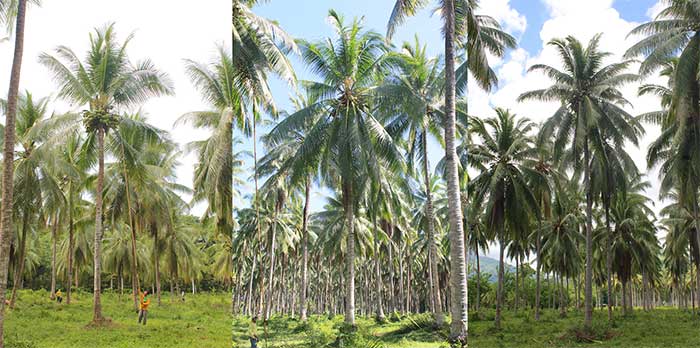
Philippine coconut production is threatened by the rising dry spells and droughts linked to climate change. A project is underway to identify heat and drought-tolerant coconut varieties to help the local industry adapt to these changing climate conditions.
The project, “Evaluation of Coconut Accessions at Philippine Coconut Authority-Zamboanga Research Center (PCA-ZRC) for Heat and Drought Tolerance Towards Hybridization,” was recently reviewed by the Philippine Council for Agriculture, Aquatic and Natural Resources Research and Development of the Department of Science and Technology (DOST-PCAARRD).
Led by Mr. Joel Gerone B. Larupay of PCA-ZRC, the project is a stepping stone toward developing climate-resilient coconut varieties. It aims to assess coconut palms’ potential and varietal responses during heat and drought stresses.
DOST-PCAARRD funds the four-year project through the Coconut Farmers and Industry Development Plan’s (CFIDP) Coconut Hybridization Program (CHP) Research.
During the review, Mr. Larupay reported that his team was able to organize and validate the weather and yield data of 16 hybrids and traditional varieties (14 dwarf and 14 tall) as potential heat and drought-tolerant coconuts for its Year 1 implementation.

The activity was part of the pre-screening and validation process of the accessions using historical yield and weather data recorded at PCA-ZRC genebank.
Initial findings from the activity indicate that San Isidro Green Dwarf (SNID) showed the highest nut per palm ratio in 2014, while both SNID and Malayan Red Dwarf (MRD) recorded the lowest copra per palm ratio in 2019.
Among the tall varieties, Baybay Tall-Advanced Generation (BAYT-AG) and Bago Oshiro Tall (BAOT) exhibited the highest nuts per palm in 2014 and 2018, respectively. Markham Valley Tall (MVT) recorded the lowest number of nuts per palm in 2020.
Copra per palm peaked in 2014 for BAYT-AG but hit the lowest in 2020 for the same variety.
To improve the project’s implementation, Science and Technology (S&T) Consultant
Violeta N. Villegas suggested considering other indicative traits of other crops correlated to heat and drought stress as additional parameters.
The development of heat and drought-tolerant varieties toward improved farm productivity is expected to benefit millions of coconut farmers, particularly from areas heavily impacted by drought and extreme temperature levels.
DOST Region IX Representative Thelma E. Diego and representatives from PCA’s Research and Development Branch (RDB), Region IX Regional Office, and CFIDP Project Management Office (PMO) attended the project review held via videoconferencing.
Director Leilani D. Pelegrina led the activity with Crops Research Division (CRD) staff, including Industry Strategic S&T Program (ISP) Manager for Coconut Alissa Carol M. Ibarra.
The report of Mr. Larupay’s team was validated during a field visit held recently at PCA-ZRC, San Ramon, Zamboanga City. (Rosemarie A. De Castro, DOST-PCAARRD S&T Media Services)



























